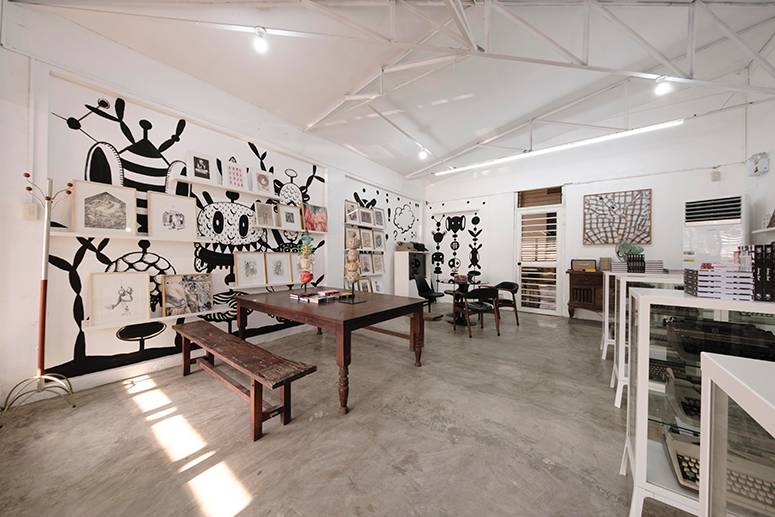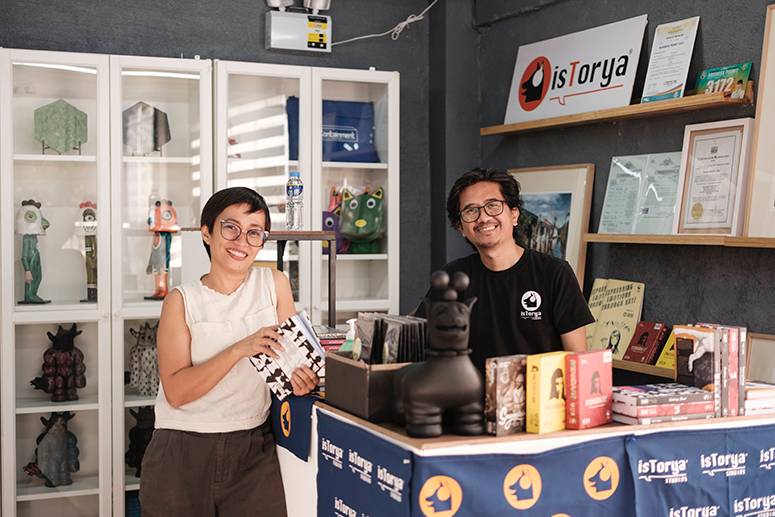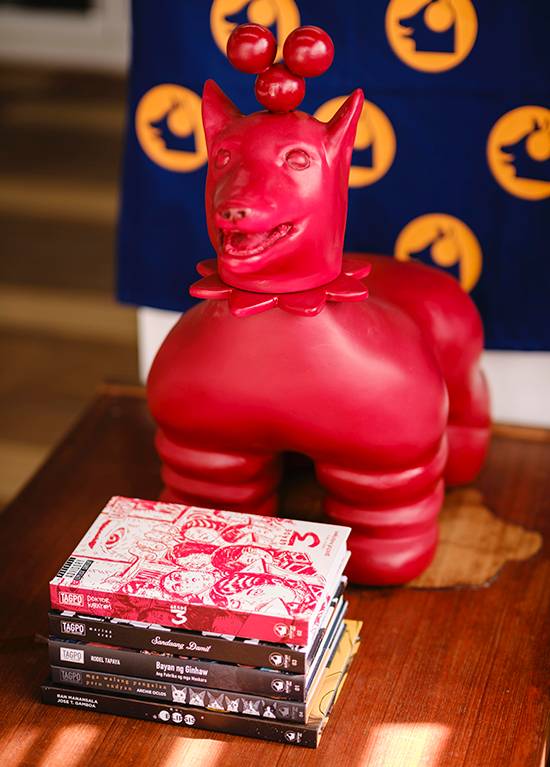Publishing as a multiplication of joy
In a subdivision of Guiguinto, the Garden Capital of Bulacan, husband-and-wife artists Rodel Tapaya and Marina Cruz have transformed their home and studio as a hub for creativity and, soon, for community engagement. Hanging proudly outside their residence is the logo of Istorya, Narrative Design Studios, both a brick-and-mortar bookshop as well as a publishing arm that transforms the visions of artists into hard-bound and well-made books.
The couple did not venture into the world of books thinking that they would become full-fledged publishers. It began during the pandemic-challenged times of homeschooling, where Rodel and Marina embarked on creating card games with their children. “It’s a family passion project that, because of homeschooling, we were forced to make Araling Panlipunan enjoyable for our children,” Marina shares. From their brainstorming sessions emerged the Sangandaan and Patandaan card games, which feature important Philippine historical figures and events.
Both established artists, Rodel and Marina have always recognized the importance of presenting their works beyond exhibitions. Early in their careers, they insisted that every art show should be accompanied by a catalog. “Naniniwala kami na nag-exist yung show kapag may catalog. Binabalik-balikan namin,” states Rodel, emphasizing their belief in documentation and archiving. After all, exhibitions, though longer than other forms of artistic expressions, are still time-bound.

As their artistic journey unfolded, the couple explored the possibility of expanding their creative horizons beyond the gallery walls. As passionate readers, they have always had an insight into the power of the printed word. A family hangout would mean a trip to their favorite bookstore. Marina, in love as well with the typographical materiality of letters, has a formidable collection of typewriters.
Rodel and Marina envision Istorya Studios as a platform for the community, where the space is not only filled with books and artworks but also shared with others.
Even their works are imbued with shimmering narrative threads. For instance, Rodel has been essaying stories of Philippine folklore through paintings of stupendous scale. In contrast, Marina’s artistic expression takes the form of meticulously painted dresses on canvas, delving into the realms of memory, personal history, and material culture.
For the initial salvo of Istorya Studios under its “Tagpo” series came Rodel’s Bayan ng Ginhaw: Ang Pabrika ng mga Maskara, which originated from the painting of the same title and was shown at Boston Gallery in 2005. A fictional town but referencing Maginhawa Street and the neighborhood of Tapaya’s childhood in Montalban, Rizal, Ginhaw, like Gabriel Garcia Marquez’s Macondo, is both character and setting in which the inhabitants start to mysteriously lose their eyes.

Alongside the illustrated collection of stories titled Gasera ng Paglingap, Rodel’s book was launched at Art Fair Philippines last year. Istorya Studios was part of the fair’s Incubator program, which shines a spotlight on emerging art spaces and projects. The couple’s brainchild is back in this year’s iteration of the country’s biggest art fair happening from Feb. 16 to 18, at The Link in Makati City. This time, Rodel and Marina will be presenting additional titles: Doktor Karayom’s Grade 3, Marina’s Sandaang Damit, and Archie Oclos’ Mga Walang Pangalan Pero Andyan. After the launch, the books will be available on the website, www.istoryastudios.ph.
The Tagpo series, sparked by Bayan ng Ginhaw, evolved into the idea of collaborating with practicing artists who weren’t necessarily illustrators. “Ano kaya kung yung practicing artist na hindi talaga ilustrador ang pagawan natin?” wondered Tapaya. The couple felt that, surely, some artists have personal projects tucked in their drawers just waiting to see the light of day.

Unlike conventional graphic novels, the Tagpo books present strings of vignettes or flashes of narratives, accompanied by images in the characteristic style of the artists, allowing for a more open and generative storytelling. Doktor Karayom’s stories, for instance, are anchored on illustrations, rendered in the artist’s signature blood red, explicated through irreverently humorous captions. Not only a visual translator, the artist is now an author.
More than ever, the power of print has become particularly evident to the couple as they witness how sharing stories enables them to reach out to other artists, such as poets, musicians, and filmmakers, and to audiences beyond the usual art circles. “We realize that publication has the power to multiply. Na-mu-multiply yung saya. Yung sarili naming experience na-e-experience din ng iba,” notes Marina.
Rodel and Marina envision Istorya Studios as a platform for the community, where the space is not only filled with books and artworks but also shared with others. “I-o-open namin yung space,” declares Tapaya, expressing their desire to make their former home a center for talks, workshops, and fairs, especially for independent creators. In the meantime, they are focused on casting their nets wider and publishing more titles, extolling the solace of books and the empathy-inducing capacity of reading. “Reading,” states Marina, “deepens one’s practice and individuality as you assume a perspective other than your own.”


